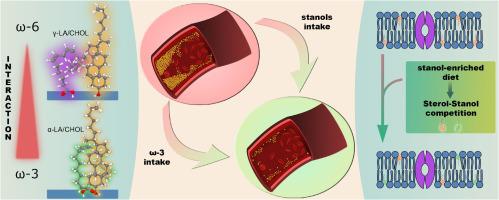Chemistry and Physics of Lipids ( IF 3.4 ) Pub Date : 2020-09-04 , DOI: 10.1016/j.chemphyslip.2020.104968 J L Fidalgo Rodríguez 1 , P Dynarowicz-Latka 2 , J Miñones Conde 1

|
The Langmuir monolayer technique has long been known for its usefulness to study the interaction between molecules and mimic cellular membranes to understand the mechanism of action of biologically relevant molecules. In this review we summarize the results that provided insight into the potential mechanism for lowering the plasma level of cholesterol by hypocholesterolemic substances (unsaturated fatty acids (UFAs) and phytocompounds) - in the aspect of prevention of atherosclerosis - and their effects on model biomembranes. The results on UFAs/cholesterol (oxysterols) interactions indicate that these systems are miscible and strongly interacting, contrary to immiscible systems containing saturated fatty acids. Lowering of cholesterol plasma level by UFAs was attributed to the strong affinity between UFAs and sterols, resulting in the formation of high stability complexes, in which sterols were bound and eliminated from the body. Studies on the effect of UFAs and plant sterols/stanols on simplified biomembranes (modeled as cholesterol/DPPC system) indicated that the studied hypocholesterolemic substances modify the biophysical properties of model membrane, affecting its fluidity and interactions between membrane components. Both UFAs and plant sterols/stanols were found to loosen interactions between DPPC and cholesterol and decrease membrane rigidity caused by the excess cholesterol in biomembrane, thus compensating strong condensing effect of cholesterol and restoring proper membrane fluidity, which is of utmost importance for normal cells functioning. The agreement between model - in vitro - studies and biological results prove the usefulness of the Langmuir monolayer technique, which helps in understanding the mode of action of biologically relevant substances.
中文翻译:

不饱和脂肪酸和植物甾烷醇如何影响固醇的血浆水平和细胞膜?回顾涉及Langmuir单层技术的模型研究。
长期以来,Langmuir单层技术因其用于研究分子与模拟细胞膜之间的相互作用,了解生物学相关分子的作用机理的实用性而闻名。在本综述中,我们总结了这些结果,从而为预防动脉粥样硬化方面的降胆固醇药(不饱和脂肪酸(UFAs)和植物化合物)降低血浆胆固醇水平的潜在机制提供了见解-以及它们对模型生物膜的影响。关于UFA /胆固醇(氧固醇)相互作用的结果表明,与包含饱和脂肪酸的不混溶系统相反,这些系统可混溶且相互作用强烈。UFA降低胆固醇血浆水平的原因是UFA与固醇之间的亲和力强,导致形成高稳定性复合物,其中固醇被结合并从体内清除。关于UFA和植物固醇/甾烷醇对简化的生物膜(建模为胆固醇/ DPPC系统)的影响的研究表明,所研究的降胆固醇物质会改变模型膜的生物物理特性,影响其流动性和膜组件之间的相互作用。发现UFA和植物固醇/甾烷醇都可放松DPPC与胆固醇之间的相互作用,并降低生物膜中过量胆固醇引起的膜刚性,从而补偿胆固醇的强冷凝作用并恢复适当的膜流动性,这对于正常细胞的功能至关重要。模型之间的协议- 其中固醇被结合并从体内消除。关于UFA和植物固醇/甾烷醇对简化的生物膜(建模为胆固醇/ DPPC系统)的影响的研究表明,所研究的降胆固醇物质会改变模型膜的生物物理特性,影响其流动性和膜组件之间的相互作用。发现UFA和植物固醇/甾烷醇都可放松DPPC与胆固醇之间的相互作用,并降低生物膜中过量胆固醇引起的膜刚性,从而补偿胆固醇的强冷凝作用并恢复适当的膜流动性,这对于正常细胞的功能至关重要。模型之间的协议- 其中固醇被结合并从体内消除。关于UFA和植物固醇/甾烷醇对简化的生物膜(建模为胆固醇/ DPPC系统)的影响的研究表明,所研究的降胆固醇物质会改变模型膜的生物物理特性,影响其流动性和膜组件之间的相互作用。发现UFA和植物固醇/甾烷醇都会放松DPPC与胆固醇之间的相互作用,并降低生物膜中过量胆固醇引起的膜刚性,从而补偿胆固醇的强冷凝作用并恢复适当的膜流动性,这对于正常细胞的功能至关重要。模型之间的协议- 关于UFA和植物固醇/甾烷醇对简化的生物膜(建模为胆固醇/ DPPC系统)的影响的研究表明,所研究的降胆固醇物质会改变模型膜的生物物理特性,影响其流动性和膜组件之间的相互作用。发现UFA和植物固醇/甾烷醇都可放松DPPC与胆固醇之间的相互作用,并降低生物膜中过量胆固醇引起的膜刚性,从而补偿胆固醇的强冷凝作用并恢复适当的膜流动性,这对于正常细胞的功能至关重要。模型之间的协议- 关于UFA和植物固醇/甾烷醇对简化的生物膜(建模为胆固醇/ DPPC系统)的影响的研究表明,所研究的降胆固醇物质会改变模型膜的生物物理特性,影响其流动性和膜组件之间的相互作用。发现UFA和植物固醇/甾烷醇都可放松DPPC与胆固醇之间的相互作用,并降低生物膜中过量胆固醇引起的膜刚性,从而补偿胆固醇的强冷凝作用并恢复适当的膜流动性,这对于正常细胞的功能至关重要。模型之间的协议- 发现UFA和植物固醇/甾烷醇都可放松DPPC与胆固醇之间的相互作用,并降低生物膜中过量胆固醇引起的膜刚性,从而补偿胆固醇的强冷凝作用并恢复适当的膜流动性,这对于正常细胞的功能至关重要。模型之间的协议- 发现UFA和植物固醇/甾烷醇都可放松DPPC与胆固醇之间的相互作用,并降低生物膜中过量胆固醇引起的膜刚性,从而补偿胆固醇的强冷凝作用并恢复适当的膜流动性,这对于正常细胞的功能至关重要。模型之间的协议-体外研究和生物学结果证明了Langmuir单层技术的有用性,该技术有助于理解生物学相关物质的作用方式。











































 京公网安备 11010802027423号
京公网安备 11010802027423号